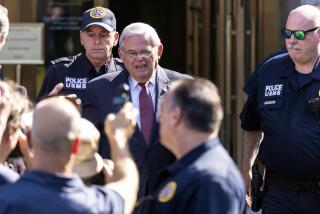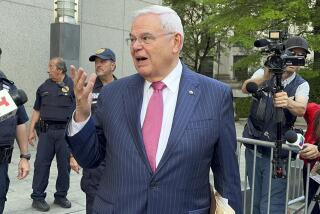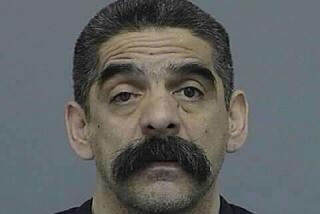Vesco Saga: U.S. Closing In on Millionaire-on-the-Run : Fraud: Officials send lawyer to Cuba to seek extradition of fugitive financier. It would mark end of 23-year odyssey.
- Share via
WASHINGTON — There may never have been, and there may never be, another “fugitive financier” quite like Robert L. Vesco.
For one thing, Vesco always knew the value of a dollar--especially the millions of dollars he allegedly squirreled away without the consent of their previous owners.
For the record:
12:00 a.m. June 11, 1995 For the Record
Los Angeles Times Sunday June 11, 1995 Home Edition Part A Page 3 Metro Desk 1 inches; 29 words Type of Material: Correction
Vesco case: A headline in Saturday’s editions stated that federal prosecutors sent a senior attorney to Cuba to seek the extradition of fugitive financier Robert L. Vesco. The attorney was sent to Miami.
After more than two decades of living lavishly on the lam in and around the Caribbean, he seemed Friday to be headed for the waiting embrace of the Justice Department.
Federal prosecutors dispatched a senior attorney to Miami to oversee the final preparation of legal niceties aimed at extraditing him from Cuba, where the bearded and all-but-forgotten Vesco has owned an opulent villa for the last 12 years.
If the extradition is successful, it not only will mark a turn in U.S.-Cuban cooperation, but it also will bring to an end a legendary odyssey.
This millionaire-on-the-run took flight 23 years ago after being charged by the U.S. government with a huge mutual funds embezzlement scheme totaling $224 million. And there were other allegations: of trying to buy government cooperation through an illegal $200,000 cash donation to the campaign to reelect President Richard Nixon in 1972 and, more recently, of cocaine smuggling.
From his various bases in the Bahamas, Costa Rica, Antiqua, Nicaragua and, finally, Cuba, Vesco seemingly thumbed his nose at U.S. authorities and the investors who had once believed in him. Throughout the 1970s and 1980s he jetted about in his private planes--including a custom Boeing 707 equipped with a sauna and disco--or cruised on his luxurious yacht. There were accusations that he was involved in the drug trade with Carlos Lehder, the now-jailed kingpin of the Medellin cocaine cartel.
Throughout his life in exile, he took pains to cultivate his hosts, and would move on when the hospitality wore thin. In his early years as a fugitive, he loaned $2.15 million to Costa Rica’s then-president, Pepe Figueres, who allowed him to live in a palatial home guarded by armed toughs and an intricate set of television cameras. In those days, Vesco would meet with reporters and deny any improprieties, and usually left the impression that he missed life in the United States and would return home without hesitation if he could work out his problems with federal authorities.
*
Furnishing several mansions in recent years at or near Havana, Vesco adopted a lifestyle far above that of the Cuban people or their leaders. It was unclear Friday exactly why Cuba authorities had detained him. White House Press Secretary Mike McCurry told reporters, “we’re attempting to determine on what basis he’s being detained,” though he said it appears to be for alleged offenses in Cuba.
In any event, as a result of his arrest, Vesco is now less a rich man in charge of his own fate than he is a figure in the complex and changing relationship between Cuba and the United States.
On Friday, outside Vesco’s whitewashed villa in Atabey, a residential district of west Havana, a man who said he was an employee of the Interior Ministry told reporters that Vesco was “under investigation” at Villa Marista, the headquarters of state security in the Cuban capital.
Vesco’s home appeared to be deserted Friday, and its front door was sealed shut with tape, Reuters news service reported.
Vesco, 59, once was an unlikely candidate for the jet set. The son of an auto worker, he began his working career by helping to design automobile grills.
In 1960, Vesco was maintaining a quiet middle-class existence as a $200-a-week engineer with Olin Mathieson Chemical Co. in New York City.
Vesco commuted by train each day from a rented Connecticut home that he shared with his wife and children. Vesco later spent time selling aluminum storm windows, but he had bigger ambitions.
Vesco then founded a New Jersey machine tool company called International Controls Corp. that specialized in making parts for the National Aeronautics and Space Administration. That company, the joining of several small engineering and electronic firms, was formed using such rough takeover tactics that the deal twice landed Vesco in court. But the company brought Vesco his first $1 million by 1970.
He then bought Investors Overseas Services, a Geneva investment firm, from its founder, British playboy and businessman Bernard Cornfeld. Vesco promised to bail out the struggling mutual fund empire with new capital.
Instead, the Securities and Exchange Commission charged in November, 1972, Vesco pulled off “one of the largest frauds ever perpetrated.”
*
The SEC accused Vesco of selling off IOS’ blue-chip U.S. holdings and shipping the money out of the country. The funds allegedly were put into small, virtually unknown or allegedly nonexistent companies in Central America and the Caribbean, where the money could be used for Vesco’s personal purposes, the SEC charged.
Institutions and ordinary investors who had bought shares in the Geneva-based investment firm’s mutual funds found their holdings to be worthless.
Vesco denied all the charges, saying that the investments were sound transactions made with an eye toward helping developing countries.
In 1972, Vesco funneled an illegal $200,000 contribution to Nixon’s reelection campaign, authorities said in court papers. They called it a ploy to get Atty. Gen. John N. Mitchell and Commerce Secretary Maurice H. Stans to fix his fraud case.
After a short stay in the Bahamas to avoid the reach of U.S. law, Vesco moved to Costa Rica in 1973. Five years later, when a new Costa Rican president threatened to arrest him, he relocated in the Bahamas. In July, 1981, he left the Bahamas after the failure of another of his businesses, the Bahamas Commonwealth Bank.
A few months later Vesco was spotted in Antigua, and he later showed up in Nicaragua, where he began to get involved in cocaine trafficking, according to congressional testimony.
He moved to Cuba in 1983 with his wife and at least two of his five daughters. Six years later he was indicted by a federal grand jury in Florida on charges of conspiring with Medellin leader Carlos Lehder to smuggle cocaine into the United States.
Administration officials stressed that the abrupt detention of Vesco in Cuba was undertaken solely by Cuban officials without pressure from the United States.
State Department spokeswoman Christine Shelly on Friday said that “we have told the government of Cuba that we are interested in getting Mr. Vesco back in the United States, as there are pending charges against him in the United States, and that we will be happy to provide them with some further details.”
Asked if the Clinton Administration specifically had sought his arrest, McCurry replied: “I’m not aware of any conversations that occurred prior to Mr. Vesco’s detention . . . related to his detention.”
Justice Department sources and private attorneys said the exact procedure for getting Vesco back to the United States remains somewhat uncertain, in view of the United States’ refusal to give full diplomatic recognition to the regime of Fidel Castro and its near-total trade embargo on the island nation.
“I wouldn’t go down to the Tarmac yet and wait for Vesco to arrive,” one official said.
However, if the Castro government wanted to hand over Vesco as a sign of its willingness to improve relations with the United States, he could be returned relatively soon, others said.
Seymour Glanzer, a former federal prosecutor experienced in immigration and extradition matters, said that in view of Cuba’s status, Vesco would be powerless to prevent any decision by authorities there to relinquish him.
“There’s no way to defend against it,” Glanzer said. “He would be whisked into the United States and that’s it.”
Glanzer said “an informal, physical turnover” of Vesco was more likely than a formal extradition procedure initiated by the United States.
Justice Department officials, however, said the United States might try to use an old extradition treaty with Cuba that dates back to 1904--before Castro was born. One official said Castro recognized that treaty in returning a few airplane hijackers to the United States during the 1970s, which seems to set a precedent.
To speed the decisions, Mark Richard, a senior career official in the department’s criminal division, has flown to Miami to begin contacts there, sources said.
Philip T. White, who formerly headed the department’s office of international affairs, said Latin American nations often prefer “informal extradition” of criminal suspects who are not citizens of their countries. White said Cuba “may just want to shove him across the border” or deport him to the United States.
At the State Department, Shelly said Cuba has signaled its interest in sending Vesco back by asking for details of the U.S. charges against him. However, she said Vesco’s detention had not been discussed in the secret talks in Toronto that occurred several weeks ago between Undersecretary of State Peter Tarnoff and Cuban envoy Ricardo Alarcon. Those rare face-to-face negotiations produced the new Administration policy of sending Cuban asylum-seekers back to the island.
Times staff writer Stanley Meisler contributed to this story from Washington. Jackson reported from Washington and Rivera Brooks from Los Angeles.
(BEGIN TEXT OF INFOBOX / INFOGRAPHIC)
The Vesco Saga
The Robert L. Vesco case was described at the time as the biggest multinational business crime ever. The scandal featured a complex web of shell companies and corporate networks.
THE ACCUSATIONS
1970: Vesco, who owns a machine tool company, buys control of a Swiss-based mutual fund, Investors Overseas Services.
1972: SEC charges Vesco with looting $224 million from the mutual fund.
1972: Vesco allegedly tries to halt the SEC investigation by giving $200,000 in campaign contributions to then-President Richard Nixon’s re-election effort.
1980: Senate investigators say he tried to buy off the Jimmy Carter Administration to get cargo planes for Libya. When nobody would assist, they said, he arranged for the Libyans to pay Billy Carter $220,000--an effort apparently aimed at embarrassing his brother, the President.
1985: U.S. Customs official accuse Vesco of collaborating with Fidel Castro’s Cuba and Nicaragua’s Marxist government to bring cocaine into the United States.
1987: A U.S. attorney identifies Vesco as a co-conspirator in Medellin cartel boss Carlos Lehder’s cocaine shipments from a Bahamian island to Florida. This accusation serves as the basis for Vesco’s extradition from Cuba.
LIFE AS A FUGITIVE
1. 1972: Disappears from the United States.
2. Mid-’70s: Spends five years in Costa Rica, with the protection of the nation’s president. When new president is elected, Vesco is expelled.
3. Late ‘70s: Moves to Bahamas. He is accused of paying off the prime minister and other Bahamian officials to ensure that he is not extradited.
4. 1981: Expelled from Bahamas. He tries to return to Costa Rica, is refused entry and goes to Cuba.
Source: Times wire reports
More to Read
Sign up for Essential California
The most important California stories and recommendations in your inbox every morning.
You may occasionally receive promotional content from the Los Angeles Times.













